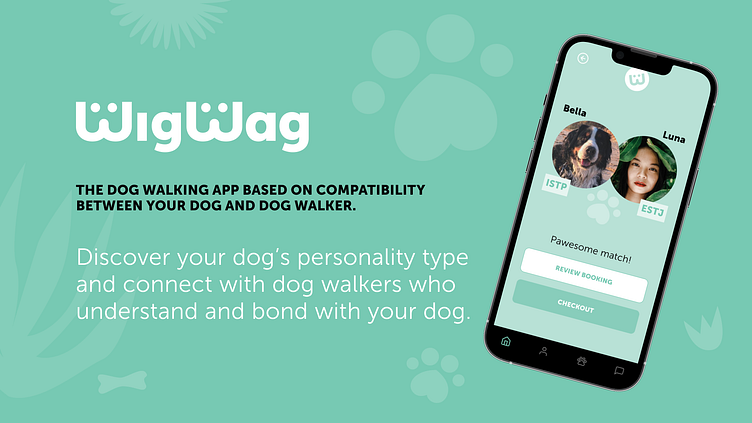WigWag - Dog Walking App
Please note this case study is an exploratory learning experience with focus on the Product Design process: Research & Empathize, Define Requirements, Ideate, Prototype, Test, Refine & Deliver, Measure & Analyze.
Project Brief
Design a dog walking app which helps connect dog owners to trustworthy dog walkers.
The Challenge
Dog owners love their dogs like they are part of their family. Sometimes due to travel or busy work schedules, they need help to find someone to care for their dog. Their main challenge is to find trustworthy dog walkers who understand and have chemistry with their dogs.
User Research
I conducted three phone interviews with dog owners to understand their needs when searching for dog walkers. All three owners mentioned the need for the dog walker to be trustworthy, reliable, local, in a reasonable price range, but most importantly for the dog walker to be a good “personality” match for their dog. Here are some of their answers when asked “What are the most important things you look for in a dog walker?”
“It’s important that my dog loves them (the dog walkers) and they love my dog. That there is chemistry between the two of them.”
“I want to see an instant bond between my dog and dog walker.”
Market Research
I found many dog walking apps but I mainly focused on Rover, Wag! and Barkly Pets. While they are highly functional and satisfy most of the dog owners’ needs, some less desirable features are:
Dog owners are forced to sign up and create an account before being able to review the app and determine if it’s the right fit for them.
Request for credit card information during account creation.
Emphasis on dog owners, dog walkers and booking rather than the dogs.
Persona
Based on my findings from the user and market research, I developed the persona of Yana Globetrotter. She is a well traveled artist who adores Bella, her fluffy Bernese Mountain Dog. When she is looking for a dog walker, she wants the best match for Bella. She wishes for the dog walker’s personality to be similar to Bella’s.
User Flow
The user flow was developed to address Yana’s particular problem in finding trustworthy walkers that match Bella’s personality type.
Before signing up, the users also have the option to browse the app. It allows them to review the app and determine if the app is suitable for them. And, after creating their profile, the dog owners must create an in-depth profile for their dogs to be able to find the most compatible dog walker.
Wireframes LoFi
Used rough sketches to create low-fidelity wireframes which establish the apps’ structure and functionality.
Wireframes HiFi
Used Figma to create high-fidelity wireframes for a few key screens: sign up, create an account, search and book dog walkers.
Visual Design
The moodboard helped initiate the visual design process. Being mindful of both dogs and dog owners' environments, it captured and influenced the natural, playful, textural and minimal look-and-feel of the app. The choice of colors are calm and soothing. And, the organic shapes and simplistic illustrations add a subtle level of playfulness while keeping the app airy and without overpowering the app’s functionality and purpose.
Prototype & Testing
Tested the prototype with one user. Based on the user’s feedback, the app was updated so that the personality test and compatibility features are predominant throughout the app.
See the WigWag prototype in action.
Refine & Deliver
The screens below highlight some of the UX/UI improvements based on the user’s feedback.
Measure & Analyze
Since this is a practice project to learn about the Product Design process, there isn’t any real performance review and feedback that can be measured and analyzed.
After completing the project, I have a good understanding about the Product Design process and what’s involved at each stage: Research & Empathize, Define Requirements, Ideate, Prototype, Test, Refine & Deliver, and Measure & Analyze. I also had a chance to familiarize myself with and use Figma and FigJam to complete the project. And, the useful resources shared by the mentors, guest speakers, dribbble community and team-mates throughout this course will definitely be useful while I continue to expand and improve my Product Design skills.
Credits
Thanks dribbble for offering this awesome course.
—
Thanks Jesse Showalter for creating such a well organized, detailed and easy to navigate course.
—
Thanks Valerie Downs for your guidance, insights, feedback and patience. You are amazing!


















